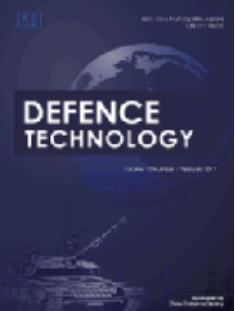Dynamic response characteristics of metal cylindrical shell driven by explosive charge with waveform regulator
IF 5.9
Q1 ENGINEERING, MULTIDISCIPLINARY
引用次数: 0
Abstract
Waveform regulator in charge is a method that can realize multi-source detonation wave superposition through a single point detonation. The method does not need to weaken the strength of shell, and relies on the high stress generated by superposition to cut shell into regular fragments. Additionally, it can be combined with different initiation methods to alter the fragmentation outcomes. In this study, aiming at the fracture strain of metal cylindrical shell driven by explosive charge with waveform regulator, theoretical analysis was first adopted to obtain the prediction model of the fracture strain of cylindrical shell with waveform regulator and the model of the axial distribution of the stress concentration factor. On this basis, both theoretical analysis and numerical models were utilized to investigate the effect of waveform regulator on the initial velocity of fragments. Finally, experiments were conducted to validate the fracture strain prediction model for cylindrical shell with waveform regulator. The research results show that the collision angles of the detonation waves at different axial positions are different, which leads to the stress concentration factor on the shell presenting a trend of gradually decreasing, then sharply increasing, and then rapidly decreasing along the axial direction. Additionally, the changes in the slot spacing and the thickness of outer charge will also affect the stress concentration factor, and the influence of outer charge thickness is relatively large. The smaller the ratio of charge volume to waveform regulator volume, the larger the axial sparse wave intensity and the more the fragment initial velocity decrease. From the initiation end to the non-initiation end, the failure modes of the shell sequentially change from pure shear, to mixed tensile-shear, and finally to pure tensile failure. The experimental results are in good agreement with the calculated results of the fracture strain model, and the maximum relative error is less than 10%, which indicates that the fracture strain prediction model of the cylindrical shell with waveform regulator established in this paper by considering the increase of elastic energy per unit volume caused by stress concentration on the shell is reliable.
带波形调节器的装药驱动金属圆柱壳的动态响应特性
控制波形调节器是一种通过单点爆轰实现多源爆震波叠加的方法。该方法不需要削弱壳体的强度,而是依靠叠加产生的高应力将壳体切割成规则的碎片。此外,它可以与不同的起始方法相结合,以改变破碎结果。本研究针对带波形调节器的炸药装药驱动金属圆柱壳的断裂应变,首先采用理论分析方法,得到了带波形调节器的圆柱壳断裂应变预测模型和应力集中因子的轴向分布模型。在此基础上,采用理论分析和数值模型相结合的方法研究了波形调节器对破片初速度的影响。最后,通过实验对带波形调节器的圆柱壳断裂应变预测模型进行了验证。研究结果表明,爆震波在不同轴向位置的碰撞角度不同,导致壳体上的应力集中系数沿轴向呈现先逐渐减小后急剧增大再迅速减小的趋势。此外,槽距和外装药厚度的变化也会影响应力集中系数,其中外装药厚度的影响比较大。装药体积与波形调节器体积之比越小,轴向稀疏波强度越大,破片初速度减小越大。从起裂端到非起裂端,壳的破坏模式依次由纯剪切、拉剪混合破坏、最后到纯拉伸破坏。实验结果与断裂应变模型的计算结果吻合较好,最大相对误差小于10%,表明本文建立的考虑壳体应力集中引起的单位体积弹性能增加的带波形调节器圆柱壳断裂应变预测模型是可靠的。
本文章由计算机程序翻译,如有差异,请以英文原文为准。
求助全文
约1分钟内获得全文
求助全文
来源期刊

Defence Technology(防务技术)
Mechanical Engineering, Control and Systems Engineering, Industrial and Manufacturing Engineering
CiteScore
8.70
自引率
0.00%
发文量
728
审稿时长
25 days
期刊介绍:
Defence Technology, a peer reviewed journal, is published monthly and aims to become the best international academic exchange platform for the research related to defence technology. It publishes original research papers having direct bearing on defence, with a balanced coverage on analytical, experimental, numerical simulation and applied investigations. It covers various disciplines of science, technology and engineering.
 求助内容:
求助内容: 应助结果提醒方式:
应助结果提醒方式:


